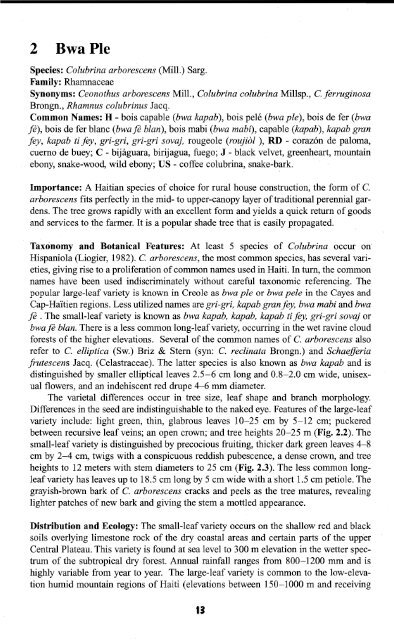Bwa-yo - Société Audubon Haiti
Bwa-yo - Société Audubon Haiti
Bwa-yo - Société Audubon Haiti
You also want an ePaper? Increase the reach of your titles
YUMPU automatically turns print PDFs into web optimized ePapers that Google loves.
2 <strong>Bwa</strong> PIe<br />
Species: Colubrina arborescens (Mill.) Sarg.<br />
Family: Rhamnaceae<br />
Synonyms: Ceonothus arborescens Mill., Colubrina colubrina Millsp., C. ferruginosa<br />
Brongn., Rhamnus colubrinus Jacq.<br />
Common Names: H - bois capable (bwa kapab), bois pele (bwa ple), bois de fer (bwa<br />
fe), bois de fer blanc (bwa fe blan), bois mabi (bwa mabi), capable (kapab), kapab gran<br />
fey, kapab ti fey, gri-gri, gri-gri sovaj, rougeole (roujiol ), RD - corazon de paloma,<br />
cuerno de buey; C - bijaguara, birijagua, fuego; J - black velvet, greenheart, mountain<br />
ebony, snake-wood, wild ebony; US - coffee colubrina, snake-bark.<br />
Importance: A <strong>Haiti</strong>an species of choice for rural house construction, the form of C.<br />
arborescens fits perfectly in the mid- to upper-canopy layer oftraditional perennial gardens.<br />
The tree grows rapidly with an excellent form and yields a quick return of goods<br />
and services to the farmer. It is a popular shade tree that is easily propagated.<br />
Taxonomy and Botanical Features: At least 5 species of Colubrina occur on'<br />
Hispaniola (Liogier, 1982). C. arborescens, the most common species, has several varieties,<br />
giving rise to a proliferation ofcommon names used in <strong>Haiti</strong>. In tum, the common<br />
names have been used indiscriminately without careful taxonomic referencing. The<br />
popular large-leaf variety is known in Creole as bwa pte or bwa pete in the Cayes and<br />
Cap-HaYtien regions. Less utilized names are gri-gri, kapab granfey, bwa mabi and bwa<br />
fe . The small-leaf variety is known as bwa kapab, kapab, kapab ti fey, gri-gri sovaj or<br />
bwa fe blan. There is a less common long-leaf variety, occurring in the wet ravine cloud<br />
forests of the higher elevations. Several of the common names of C. arborescens also<br />
refer to C. elliptica (Sw.) Briz & Stern (syn: C. reclinata Brongn.) and Schaefferia<br />
frutescens Jacq. (Celastraceae). The latter species is also known as bwa kapab and is<br />
distinguished by smaller elliptical leaves 2.5-6 cm long and 0.8-2.0 cm wide, unisex-ual<br />
flowers, and an indehiscent red drupe 4-6 mm diameter.<br />
The varietal differences occur in tree size, leaf shape and branch. morphology.<br />
Differences in the seed are indistinguishable to the naked eye. Features ofthe large-leaf<br />
variety include: light green, thin, glabrous leaves 10-25 cm by 5-12 cm; puckered<br />
between recursive leaf veins; an open crown; and tree heights 20-25 m (Fig. 2.2). The<br />
small-leaf variety is distinguished by precocious fruiting, thicker dark green leaves 4-8<br />
cm by 2-4cm, twigs with a conspicuous reddish pubescence, a dense crown, and tree<br />
heights to 12 meters with stem diameters to 25 cm (Fig. 2.3). The less common longleafvariety<br />
has leaves up to 18.5 cm long by 5 cm wide with a short 1.5 cm petiole. The<br />
grayish-brown bark of C. arborescens cracks and peels as the tree matures, revealing<br />
lighter patches of new bark and giving the stem a mottled appearance.<br />
Distribution and Ecology: The small-leaf variety occurs on the shallow red and black<br />
soils overlying limestone rock of the dry coastal areas and certain parts of the upper<br />
Central Plateau. This variety is found at sea level to 300 m elevation in the wetter spectrum<br />
of the subtropical dry forest. Annual rainfall ranges from 800-1200 mm and is<br />
highly variable from year to year. The large-leaf variety is common to the low-elevation<br />
humid mountain regions of <strong>Haiti</strong> (elevations between 150-1000 m and receiving<br />
13



